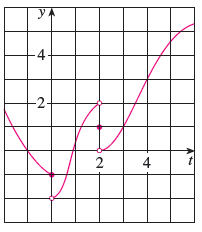
Brigitte S.
asked • 08/29/20calculus- fucntions
For the function g whose graph is given, state the value of each quantity, if it exists. (If an answer does not exist, enter DNE.)

(a) lim t → 0− g(t)
(b) lim t → 0+ g(t)
(c) lim t → 0 g(t)
(d) lim t → 2− g(t)
(e) lim t → 2+ g(t)
(f) lim t → 2 g(t)
(g) g(2)
(h) lim t → 4 g(t)
1 Expert Answer
Yuki K. answered • 08/30/20
Carnegie Mellon Graduate - Math Tutor for Algebra to AP Calculus
Think of limits as the y-value that a function approaches as your input (in this case, t) approaches the given value indicated by the arrow sign, regardless of whether or not the function exists at that point.
a) -1
b) -2
c) Since the two limits on either side do not match, the result when t approaches 0 in general is "DNE"
d) 2
e) 0
f) Do not match; DNE
g) 1
h) 3
Still looking for help? Get the right answer, fast.
Get a free answer to a quick problem.
Most questions answered within 4 hours.
OR
Choose an expert and meet online. No packages or subscriptions, pay only for the time you need.






Kevin S.
08/29/20